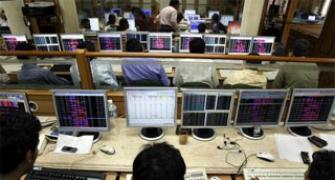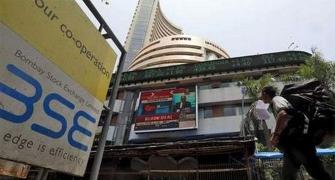Firms generated free cash flows in 2013-14, for the first time since the 2008 Lehman crisis
 Indian companies’ cash situation saw a marked improvement in 2013-14: These firms generated free cash flows (net pf capital expenditure) from their operations for the first time since the Lehman crisis of 2008.
Indian companies’ cash situation saw a marked improvement in 2013-14: These firms generated free cash flows (net pf capital expenditure) from their operations for the first time since the Lehman crisis of 2008.
BSE 500 companies together generated a little over Rs 4 lakh crore of cash from operations, higher than the Rs 332,000 used for capital expenditure during the year. This reduced the need for fresh borrowing to fund expansion. This was unlike earlier years, when cash flows from operations fell short of cash outgo on account of capex and dividend payouts to shareholders, and companies were forced to scale up borrowings for plugging the cash shortfall.
A Business Standard analysis of the combined consolidated finances of 394 of the BSE-500 companies (excluding banking & financial and oil & gas ones) for the year ended March 2014 shows the cash flow from operations in 2013-14 rose 22.7 per cent over a year earlier. The rate of growth during the year was the fastest in four years, driven mainly by higher profitability and a decline in working capital requirements.
The cash outgo on account of capex and investment declined 16.4 per cent in 2013-14, as companies lowered their capacity expansion in view of an economic slowdown. This left them with free cash flows of nearly Rs 70,000 crore (Rs 700 billion), against a similar amount of net cash outgo in 2012-13.
At its peak in 2010-11, companies’ cash burn rate exceeded their internal cash generation by Rs 1.27 lakh crore, due to a mix of low internal cash generation and faster rise in capital expenditure.
Analysts attribute this change in trend to the impact of cash-rich companies in the information technology, pharma, fast-moving consumer goods and automobile sectors, besides a cutdown on incremental capex by companies. “Export-driven companies like Tata Consultancy Services, Infosys, Sun Pharma, Dr Reddys Lab and Tata Motors now account for a bigger pie of India Inc’s revenues and profits than a few years earlier. A strong show by these companies has more than made up for the laggards in sectors like construction & infra, real estate, power and metals. Some help has also come from a sequential decline in incremental capex allowing companies to cut down on cash expenses,” says G Chhokalingam, founder and chief executive of Equinomics Research & Advisory.
The sectoral trend in cash flows validates this point. The bulk of the incremental improvement in internal cash generation was accounted for by IT exporters like TCS, Infosys and Wipro; pharma majors (Sun Pharma, Lupin and Dr Reddy’s Lab), FMCG companies (ITC, Hindustan Unilever and Dabur) and automobile manufacturers (Tata Motors and Maruti Suzuki). Other major contributors were government-owned mining companies — Coal India and National Mineral Development Corporation (NMDC).
The companies in these five sectors accounted for nearly half the internal cash generation by the entire universe of companies and most of the free cash flows from operations, in 2013-14. If it was not for these companies’ contribution, there would have been a cash hole in India Inc’s balance sheet last year as well.
Among individual companies, Tata Motors topped the chart with internal cash generation of Rs 36,151 crore in 2013-14. It was followed by Bharti Airtel (Rs 26,025 crore), NTPC (Rs 16,469 crore), Power Grid Corporation (Rs 15,259 crore) and TCS (Rs 14,751 crore).
The bad news, though, is that companies in sectors that are capex- and working capital-intensive — such as construction & infrastructure, power, metals, real estate and gems & jewellery — continue to burn more cash than they generate from their operations. In 2013-14, therefore, their indebtedness rose further, as they had to borrow to meet their cash shortfall. In the sample taken for this analysis, 18 construction & infrastructure firms together generated Rs 5,406 crore (Rs 54.06 billion) of cash from their operations last year. This was only a small fraction of their capex and investment outgo of nearly Rs 29,000 crore (Rs 290 billion) and led to a further rise in their leverage ratio to 2.8 (net of cash & equivalents) from 2.4 in 2012-13 and 1.1 in 2008-09.
Among companies with the worst cash flows in 2013-14, Larsen & Toubro topped the chart with negative internal cash generation of Rs 6,963 crore (Rs 69.63 billion). It was followed by MTNL (negative Rs 4,186 crore), Ranbaxy Labs (negative Rs 3,562 crore), Gitanjali Gems (negative Rs 2,966 crore) and Rajesh Exports (negative Rs 2,629 crore).
Metal and power companies, on the other hand, faced the problem of internal cash generation falling short of incremental capex and investment. Companies like Tata Steel, Hindalco, JSW Steel, SAIL, Jindal Saw and Bhushan Steel reported negative free cash flows, as internal cash generation fell short of capex and investment last year.
Power companies like NTPC, PowerGrid, Reliance Power, Adani Power, JP Power and CESC also reported strong cash flows from their operations but those proved inadequate to fund their incremental capex and equity dividend. They were, therefore, forced to raise additional loans. Companies like Tata Power, JSW Energy, NHPC, Neyveli Lignite, SJVN and Torrent Power, though, bucked the trend by generating free cash flows, with a sharp fall in their incremental capex.










